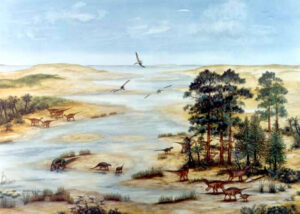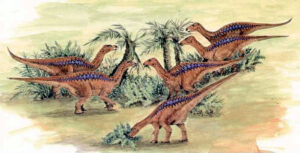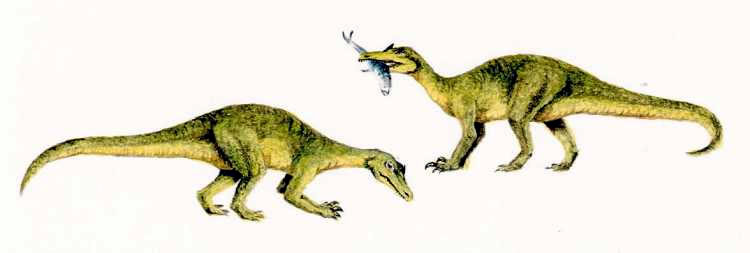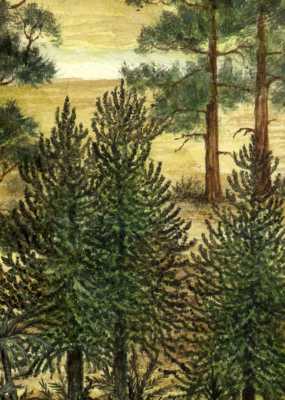The Exhibition examined three different aspects of Iguanodon
- the history of the dinosaur’s discovery;
- the nature of the animal itself, and, lastly;
- the geological formations within which Iguanodon remains have been found as well as other fossils from the same period.
Iguanodon was discovered over 160 years ago, the second dinosaur to be described scientifically. It was narrowly beaten by Megalosaurus, ironically iguanodon’s main rival 130 million years ago.
The word “dinosaur” did not exist when Iguanodon was first discovered.
Reconstructions of Iguanodon’s appearance have changed many times. The most modern reconstruction is of a large but surprisingly agile animal capable of running and swimming. Dinosaurs are no longer seen as stupid, sluggish reptiles that were out-evolved by clever, efficient mammals but as active, dynamic animals which became extinct due to misfortune rather than inefficiency. Dinosaurs were not mysterious monsters but living, breathing animals capable of sophisticated behaviour. Birds are the dinosaurs’ closest living relatives and one day it may become necessary to re-classify birds as dinosaurs.
Geology
The rocks, on which Bexhill is situated, are about 130 million years old and were formed in a geological period called the Lower Cretaceous.

They contain the fossilised remains of the plants and animals that inhabited a radically different landscape. The sea was not where it is today. The area was mostly a freshwater flood plain dominated by rivers, lakes and swamps. There appears to have been a dry season and a wet season. The temperature would have been much higher than it is today and the presence of fossilised charcoal suggest that forest fires broke out occasionally. Floods during the wet season would carry into the lakes and rivers bones that had been lying on the ground. These remains were sometimes preserved as fossils.
Vegetation consisted of coniferous trees, cycads, ferns and fern-like plants. There were as yet no deciduous trees and no grasses. Fossil plant debris is very common in the rocks exposed on the beach at low tide. Examples of amber, fossilised tree sap, have been found in Bexhill. As yet no specimen has contained preserved insects. However, remains of insects have been found in the rocks on the beach. As well as the fossilised plant remains, waterlogged wood, roots and nuts are sometimes discovered. These are from a submerged forest which dates back to the Bronze Age, some 4,000 years ago fake rolex uk.
The landscape would have been dominated by dinosaurs. Most of the fossil remains that can be identified belonged to Iguanodon, a 5 to 8 metre long plant-eating dinosaur.
Iguanodon

Iguanodon could walk either on its hind legs or on all fours, the preferred method of walking probably depending on the size and speed of the animal. The three middle fingers of its hands were used as toes when it was walking on all fours and each ended in a blunt hoof. Its thumb was modified into a sharp spike that may have been used for self-defence. Its little finger was dexterous and was probably used instead of a thumb to hold food and bring it up to its mouth. Iguanodon had many grinding teeth at the back of its mouth for chewing the tough plants that it ate, but it had no teeth at the front of its mouth. Instead it had a strong beak for biting off a mouthful of food.
Remains have been found of large meat-eating dinosaurs such as Megalosaurus. This was about the same size as Iguanodon and walked and ran on its hind legs, balanced by its tail. It had sharp, curved teeth for killing its prey, probably Iguanodon, and for biting off chunks of meat. Its fingers and toes had bird-like claws for hunting.
Baryonyx

Teeth of Baryonyx have been found in Bexhill. This was a meat-eating dinosaur similar to Megalosaurus but with a crocodile-like head and large curved claws on its hands. It is thought that Baryonyx hunted and ate mostly fish but, like a crocodile, would have eaten larger animals if the opportunity arose.
There are also bones of the armoured, plant-eating dinosaur Polacanthus. This animal walked on all fours and relied on its spiky armour, rather than speed, as a defence.
Bexhill is famous for the fossil dinosaur footprints sometimes exposed on the beach. Most of these footprints have been attributed to Iguanodon but Megalosaur prints are occasionally found.
A Bexhill Dinosaur Bone
In the lakes and rivers of the flood plain were crocodiles, turtles, fishes, freshwater sharks, crustaceans and molluscs. On land there were insects and small mammals, while the skies were still the domain of flying reptiles called pterosaurs.
Wealden woods
 The remains of plants that lived here 130 million years are the most commonly found fossils.
The remains of plants that lived here 130 million years are the most commonly found fossils.
There were trees such as conifers and monkey puzzle trees, tree ferns and seed ferns. Broad leaf trees had not yet evolved and there was no grass.
Most of the low ground cover would have been made up of various species of fern.
Charcoal is sometimes found preserved in the local rocks, this is evidence of prehistoric forest fires that would have been started by lightning. These fires probably occurred during a hot dry season, flood deposits are also found which suggest there was also a wet monsoonal season.
Amber has been found in Bexhill, this is fossilised sap from conifer trees, as yet no preserved insects have been found in the amber but more poorly preserved insect fossil have been found in the local rocks.
Acknowledgements
Bexhill Museum would like to thank the following people for their generous assistance to this exhibition:-
Mr D Brockhurst;
Mr Ken Brooks (Hastings & District Geological Society);
Mr Alf Cave;
Liz Cook (Department of Geology, Bristol University)
Mr Desmond Gispert
Mr Frank Hamill, Dr Angela Milner – National History Museum
Dr David Norman – Director, Sedgewick Museum, Cambridge
Mr Jon Radley – Museum of Isle of Wight Geology
Mr Ken Woodhams – Croydon Natural History & Scientific Society
The exhibition was put together by staff of Bexhill Museum and the following volunteers:
Find out more
Read this pdf brochure

